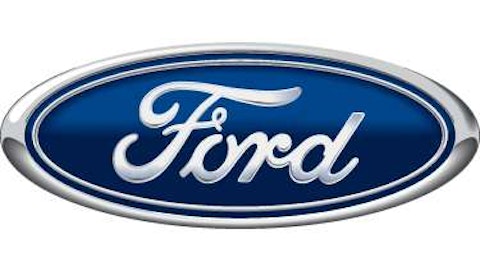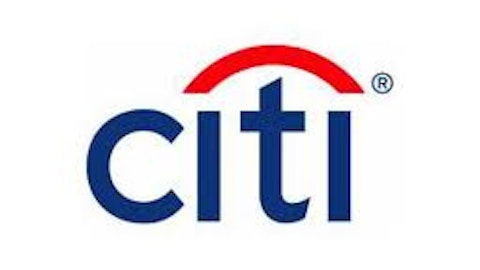Home to the Bad Boys, Smokey Robinson, and the 11-time Stanley Cup Champion Redwings, Detroit will always be famous for one thing: cars. For years, the dominance of the “Big 3” — Ford Motor Company (NYSE:F), General Motors Company (NYSE:GM), and Chrysler—helped power a Midwestern city with little else to its economic name.

Promising play
The company opened a $500 million plant in China earlier this month, doubling production capacity in an effort to keep up with rapid demand. In May, Ford Motor Company (NYSE:F) sold 70,540 vehicles in China, an increase of 45% against the previous year—three times the rate of the company’s domestic growth. Asia currently sits at nearly 20% of Ford Motor Company (NYSE:F)’s market, so doubling production in China could help Ford Motor Company (NYSE:F) to sustain that impressive growth.
A recent string of recalls brought the question of quality back to mind, at least in North America, which is a concern given that the continent amounts for almost half of Ford Motor Company (NYSE:F)’s sales. But the U.S. still saw 14% year-over-year growth in May; quality is a currently a concern, not an issue. What’s more, Ford Motor Company (NYSE:F) trades at just over 10 times earnings, much less than the industry average of 14.5 or the S&P 500 average of 16.9. Ford’s 2% dividend (nearly twice the industry average), makes it look even more promising.
Making progress
General Motors Company (NYSE:GM) is better than Ford at almost everything, except for one, key component: making money. Even though its current operating margin of almost -20% is exaggerated because of deprecation costs in Q4 2012, the company’s 2011 mark of almost 3% needs improvement. Last week, the company highlighted enormous progress in its plans to do just that. General Motors Company (NYSE:GM) now hopes that 96% of volume will be on 13 core architectures, and already has reached 71% volume on those architectures against just 31% in 2011.
In other words, General Motors Company (NYSE:GM) will cut costs by condensing its sales into a few, profitable product lines, thus allowing the company to capitalize on “economy of scale.” Like Ford, General Motors Company (NYSE:GM)’s P/E looks better than the industry average (8.0 against 14.2), and while it does not offer a dividend, General Motors Company (NYSE:GM) also boasts an EPS of over 3 (trailing-12 months of 4.2), which suggests that the company will eventually generate income to investors regardless of when—or if—it instigates a dividend.
Indirect exposure
It’s actually impossible to invest in Chrysler directly, but investors can still invest in the company indirectly: through Italian automaker Fiat (ADR) (NASDAQOTH:FIATY) or German automaker Daimler (NASDAQOTH:DDAIF), both part-owners of Chrysler (along with private company Chrysler Group). The company reported its best month since 2007 last May, when vehicle sales grew 11% to 166,596 units—this after an impressive 2012 that saw operating profit grow 47% to $2.9 billion.
The company seems prepared to sustain earnings well into the future, which bodes well for both Fiat and Daimler AG. Fiat already trades at a value equal to its current cash flows. In other words, the stock price is equivalent to the amount of money that the company earns without accounting for appreciation, while the industry on average trades at seven times that cash flow.[1]
Meanwhile, Daimler AG, which owns Mercedes-Benz, operates with a trusted brand that people not only know, but demand, helping the company to approach record numbers in the face of a struggling luxury vehicle environment. The impact of Chrysler’s growth is marginalized, but both companies look like solid buys regardless.
Bear case
As always, a bear case exists. Automakers will be susceptible to global macroeconomic trends, on the one hand, and at least some people believe that the stock market is currently overpriced. This suggests that prices may fall regardless of whether Ford, General Motors Company (NYSE:GM) and Chrysler consistently earn money. However, to the investor that takes a long-term approach, one thing is clear: the stock prices of the Big 3 (or, in Chrysler’s case, the publicly traded companies that are affected by it) do not reflect the real value of those companies.
Bottom line
For many years, Detroit automakers drove Detroit on the idea of supplying America with cars. The Big 3 might never again be “The Big 3,” but that doesn’t mean they can’t reinvent themselves, perhaps as global players in a variety of markets. But regardless of how they earn the money, they certainly seem prepared to do so well into the foreseeable future.
Will Chavey has a position in Ford. The Motley Fool recommends Ford and General Motors. The Motley Fool owns shares of Ford. Will is a member of The Motley Fool Blog Network — entries represent the personal opinion of the blogger and are not formally edited.
Copyright © 1995 – 2013 The Motley Fool, LLC. All rights reserved. The Motley Fool has a disclosure policy.


